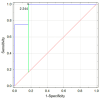Laboratory Findings and Clinical Features in IgA Vasculitis: Identifying Predictors of Kidney Involvement and Disease Relapse in Pediatric Patients
- PMID: 40364087
- PMCID: PMC12073035
- DOI: 10.3390/jcm14093055
Laboratory Findings and Clinical Features in IgA Vasculitis: Identifying Predictors of Kidney Involvement and Disease Relapse in Pediatric Patients
Abstract
Objective: This study aimed to identify clinical and laboratory predictors of kidney involvement and disease relapse in pediatric patients with IgA vasculitis (Immunoglobulin A vasculitis, IgAV). Materials and Methods: A retrospective cohort study was conducted on 173 children diagnosed with IgAV at the Children's Clinical Hospital of the Medical University of Warsaw between 2018 and 2022. Patients were categorized into groups based on renal involvement (IgAVN+ vs. IgAVN-) and disease recurrence. The analysis included demographic data, clinical manifestations, allergy history, presence of infection, duration of hospitalization, relapse occurrence, the interval between the first and second hospitalization, and laboratory markers. Results: Renal involvement was observed in 42% of cases, while disease recurrence occurred in 9.25% of patients. IgAVN+ patients were older, had longer hospital stays, and more frequently exhibited gastrointestinal symptoms, consistent with previous research. A history of allergic conditions was more prevalent in both the IgAVN+ and recurrence groups. An increase in IgA levels over time was associated with a higher risk of nephropathic development. Patients with recurrences had higher IgM levels and an elevated neutrophil-to-lymphocyte ratio (NLR) (p = 0.07). In the ROC (Receiver Operating Characteristic) analysis, a cutoff value of 1.67 for NLR (AUC 0.71; p = 0.0002; sensitivity 0.87; specificity 0.58) was identified as a risk factor for disease recurrence. Conclusions: Older age at disease onset, gastrointestinal involvement, and allergies are associated with renal involvement in pediatric IgAV. Immune dysregulation, reflected by elevated NLR and IgM, may contribute to disease recurrence. It is important to monitor changes in IgA levels over time, as an increase in IgA concentration is a risk factor for the development of nephropathy. Additionally, calculating the NLR is recommended, as it may indicate the probability of disease recurrence.
Keywords: IgA vasculitis; IgA vasculitis nephritis; disease recurrence; pediatric nephrology.
Conflict of interest statement
The authors declare no conflicts of interest.
Figures




Similar articles
-
Gastrointestinal involvement and its association with the risk for nephritis in IgA vasculitis.Ther Adv Musculoskelet Dis. 2021 Jun 30;13:1759720X211024828. doi: 10.1177/1759720X211024828. eCollection 2021. Ther Adv Musculoskelet Dis. 2021. PMID: 34262620 Free PMC article.
-
Persistence and Severity of Cutaneous Manifestations in IgA Vasculitis Is Associated with Development of IgA Vasculitis Nephritis in Children.Dermatology. 2022;238(2):340-346. doi: 10.1159/000516765. Epub 2021 Jun 7. Dermatology. 2022. PMID: 34098552
-
Predictive biomarkers of IgA vasculitis with nephritis by metabolomic analysis.Semin Arthritis Rheum. 2020 Dec;50(6):1238-1244. doi: 10.1016/j.semarthrit.2020.09.006. Epub 2020 Sep 19. Semin Arthritis Rheum. 2020. PMID: 33065418
-
Navigating Adult-Onset IgA Vasculitis-Associated Nephritis.Life (Basel). 2024 Jul 25;14(8):930. doi: 10.3390/life14080930. Life (Basel). 2024. PMID: 39202674 Free PMC article. Review.
-
IgA vasculitis.Semin Immunopathol. 2021 Oct;43(5):729-738. doi: 10.1007/s00281-021-00874-9. Epub 2021 Jun 25. Semin Immunopathol. 2021. PMID: 34170395 Review.
References
LinkOut - more resources
Full Text Sources
Miscellaneous

